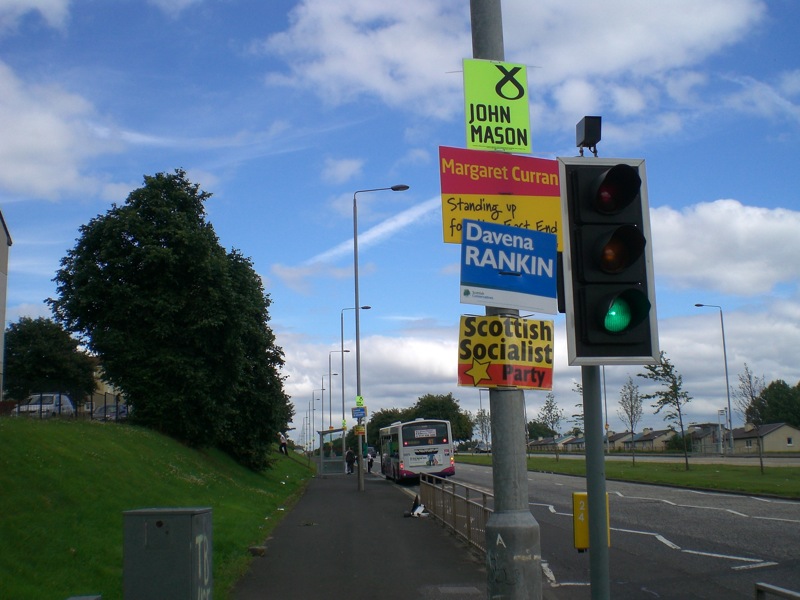Competing “yes” banners and “no thanks” posters were among the most colourful features of the referendum campaign, but as May’s general election hoves into view there will be less political posters than ever on Scotland’s streets.
Experts fear that the lack of posters could depress turnout.
Just a handful of Scottish councils permit candidates and parties to display election material on lampposts and other “street furniture”.
Of Scotland’s 32 council areas just four – Shetland, the Highlands, the Western Isles, and Argyll and Bute – now allow political posters on council property.
The number of councils passing legislation banning political material on their property has increased dramatically since the last general election in 2010.
Last year, Inverclyde, West Dunbartonshire and North Ayrshire all moved to outlaw election posters. South Lanarkshire will follow suit in a matter of weeks.
The main reason cited for the bans is the expense of removing election material from council property after the country goes to the polls.
But an expert fears that the lack of posters could contribute to lower turnouts and have a deleterious effect on Scottish democracy.
“People often don’t pay attention to politics. They need every reminder they can get (to turn out to vote). One way of reminding people is by posters in localities. It is important for democratically getting people out to vote and mobilising them,” says Alistair Clark, senior lecturer in politics at Newcastle University.
There is a strong link between the visibility of political campaigns and higher turnouts, says Clark.
The decision to ban political posters is “a peculiarly self-denying ordnance from councils,” Clark says.
While councils cite the cost of removing posters, there already exists legislation requiring parties to remove election material after polls close.
There appears to be little party political variation on the decision to ban political posters with councils of all strips across Scotland outlawing them.
“Most Scottish councils are run by a mix of parties and coalitions. You can’t say it is one party against another,” says Clark. “It is a broader council issue. It just seems to be that this will cost us money.”
The outlawing of election material on council property means Scotland is out step, both with rest of Europe, where political posters are a common sight, and even other parts of the UK.
“Northern Ireland in the run-up to May you’ll find is postered from one end of the street to another,” says Clark.
“Scotland somehow has become an outlier here. It is strange given the democratic experience of the referendum that this is something that is being allowed to happen.”
Juliet Swann, campaigns and research officer at Electoral Reform Society Scotland, says that election posters add colour to political campaigns but that the best way to ensure that the enthusiasm of the referendum is not lost is to make sure people feel that their vote counts.
“Perhaps celebrating elections more as a carnival of democracy, complete with colourful election posters would bring some public enthusiasm back into politics. But the only way to be sure of re-engaging the people in politics is to make them feel like their vote counts for something,” she said.
Alistair Clark called on Scottish councils to overturn the ban on election material on their property.
“The danger is that people just won’t go out and vote. It is pointless complaining about turnout unless people are given every encouragement to vote. And among that encouragement are posters being permitted to be placed in places where people might see them.”
Where election posters are banned.
| Local Authority | Posters allowed? | Notes |
|---|---|---|
| Aberdeen city | no | |
| Aberdeenshire | no | Prohibited in Aberdeenshire for 'a number of years.' |
| Angus | no | No election materials to be attached to lamp standards. |
| Argyll and Bute | yes | Considered ban in January, but decided against ban. |
| Western Isles | yes | Council has 'liberal policy.' |
| Clackmannanshire | no | Long established' policy banning election posters. |
| Dundee | no | Election materials banned on all council property. |
| Dumfries | no | |
| East Ayrshire | no | |
| East Dumbartonshire | no | |
| Edinburgh | no | |
| East Lothian | no | No political information on street furniture. |
| East Renfrewshire | no | Advise political parties not to put up posters. Will be taken down. |
| Glasgow | no | Ban in force for approx 7 years. |
| Falkirk | no | Ban 'came in a few years back.' |
| Fife | no | No campaign material on any street furniture. |
| Highland | yes | Last considered policy in December 2014. |
| Invercylde | no | Ban imposed in 2014. |
| Midlothian | ||
| Moray | no | |
| North Ayrshire | no | Ban imposed in October 2014. |
| North Lanarkshire | no | Ban decision made a few weeks ago. |
| Orkney | yes | Decision to ban expected soon. |
| Perth and Kinross | no | Any posters identified will be removed.' |
| Renfrewshire | no | Council agreed a ban policy a 'couple' of years ago. |
| Scottish Borders | no | No election notices on Council owned property. |
| Shetland | yes | No ban but permission must be sought from council officials. |
| South Ayrshire | no | |
| South Lanarkshire | no | In process of banning them. |
| Stirling | no | |
| West Dunbartonshire | no | Ban agreed in December 2014. |
| West Lothian | no | Ban agreed in 2014. |
Header image credit: Xabier Cid | CC | https://flic.kr/p/57mJbq
Second image credit: Akuppa John Wigham | CC | https://flic.kr/p/Jk5yz
A version of this story was first printed in The National














